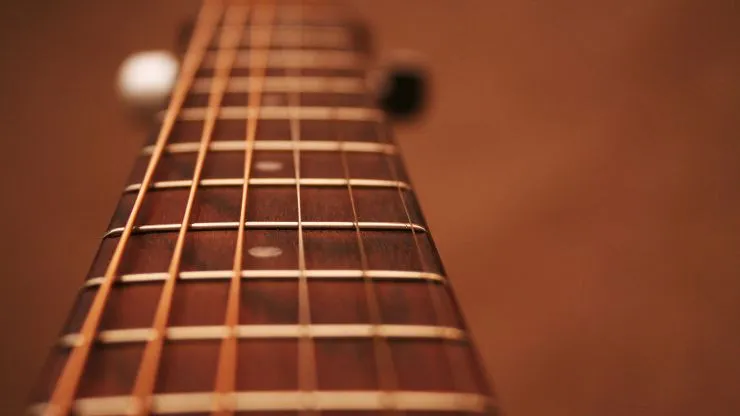When purchasing your shiny new guitar, you’ll probably have a few factors in mind that you want the guitar to tick off. Maybe you want a mahogany body guitar for classic warmth and resonance, or you want to brighten your tone with a maple fretboard. Perhaps, active pickups are a dealbreaker for you and your chugging needs. But before looking at any of these components, let’s first consider what scale is right for you.
What Is Guitar Scale Length or Size?
A guitar’s scale (not to be confused with note scales) is essentially the length of the instrument’s active, vibrating section of strings. Therefore, the scale measures the area between a guitar’s bridge and the nut. While you might occasionally see the scale measured in millimetres, particularly in Europe, it’s generally measured in inches. However, it would be best if you took this measurement more as a rough guide rather than an exact size, as there can be slight differences in the scale length depending on how the bridge’s string saddles are positioned. Guitar bridges commonly feature individual saddles, which change individual strings’ intonation by moving them back and forth, resulting in a longer or shorter scale for that string.
Why Does Guitar Scale Matter?
Scale length can significantly affect a guitar’s playability and tone. It can also make certain guitars more or less suitable to specific music genres.
Playability
The way a guitar feels when playing is often due to the instrument’s scale. A longer scale normally means the guitar has wider fret spacing, increasing the distance between frets. With a scale of 25.5”, a Fender Stratocaster is only marginally longer than the 24.75” scale of a Gibson Les Paul, for instance, so finding frets won’t feel hugely different while playing. But compared with a baritone guitar, which can typically be up to 30.5”, the playing experience is massively different.
Similarly, longer-scaled guitars require more tension to maintain the same pitch. This means that more physical force is needed to play and control strings, such as with vibrato and bending techniques. Guitars with a short scale have less tension, making it easier to manipulate the strings. While this can produce a less tight sound, it’s often warmer and more expressive.
Tuning
A guitar’s scale can also affect a particular instrument’s suitability for different tuning setups. The lower you tune your guitar, the less tension you’ll have in the strings. Thicker strings can mitigate this problem to a certain extent. However, if you are playing with particularly low tunings, for instance downtuning an 8-string guitar to a low E or drop D, then you’re going to want a longer scale that can handle the situation.
Tone
The resulting tonal output can significantly change as tension increases or decreases with different scale lengths. Typically, a guitar with a longer scale and more tension will benefit from a tighter tone with increased low-end clarity. The trade-off is that the highs can end up a little too bright, which might not be to your tastes.
Shorter scales, like those deployed by classic Gibson guitars, tend to have a looser sound than their longer-scaled colleagues. However, what they lack in tightness, they make up for with better all-round clarity, vintage warmth, and superior treble.
Beyond just affecting tension, scale length colours a guitar’s harmonic qualities, including overtones and natural harmonics. Simply put, with all else being equal, two guitars with different scales will naturally have different tone qualities.
Common Scale Lengths
So, now that we know the role that scale plays in a guitar’s sound and playability, let’s take a closer look at standard scale options. You might already know some of the aural qualities of particularly iconic guitars, such as a classic Fender Strat. And it’s in no small part that the scale of these legendary instruments contributes to their classic sound.
Common Guitar Scales
-
Fender Jaguar: 24”
-
Steel-string acoustic guitar: 24” – 25.5”
-
Gibson: 24.75”
-
Standard PRS Guitars: 25”
-
Fender Stratocaster, Telecaster, & Jazzmaster: 25.5”
-
Classical guitar: 26”
-
7-string guitars: 25.5” – 27”
-
8-string guitars: range from the short scale of 25.5” up to 28”
-
Baritone guitars: 26.5” – 30”
Common Bass Guitar Scales
-
Short-scale bass: 30”
-
Medium-scale bass: 32”
-
Standard or long-scale bass: 34”
-
5-string bass: 35”
-
Extra-long scale bass: 36”
Finding Your Perfect Guitar Scale
The scale you need depends entirely on the noise you want to make. If you’re going to explore a djenty, downtuned, modern metal sound, then not only could more strings come in handy, but a longer scale could also be essential to support you through alternative tunings and dynamic ranges. A Fender Jaguar probably isn’t going to cut the mustard! But a shorter scale could be the way to go if you have designs on a vintage revival, classic riff-laden sound.
Whatever scale you need, head over to our Finder tool, where you can enter specific search parameters to find the axe of your dreams!

